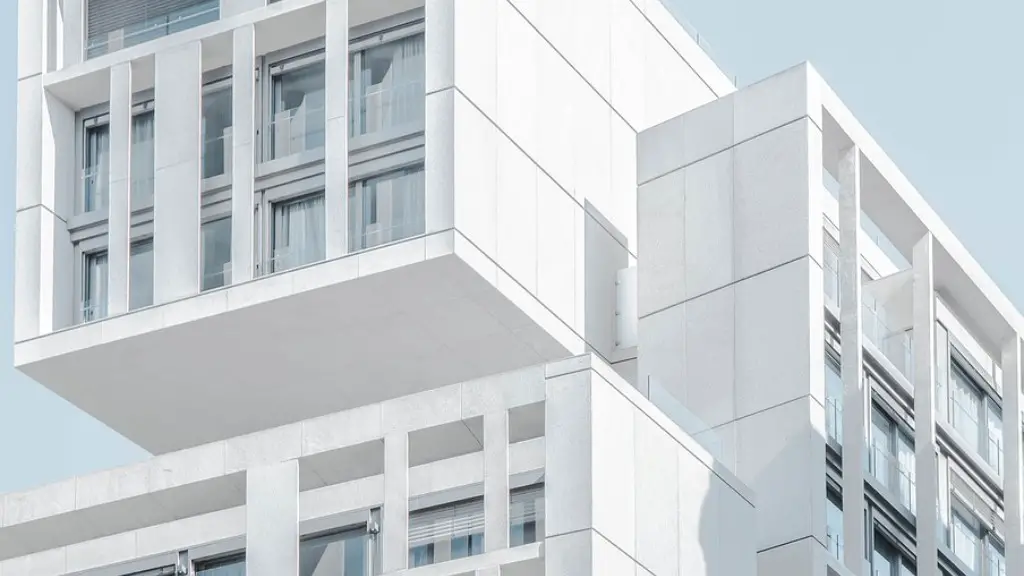Climate change is likely to have a profound effect on architecture. The most obvious impact will be an increased need for buildings to be made more resilient to extreme weather events, but climate change will also affect the way buildings are used and occupied. The rising temperatures and changes in precipitation patterns will mean that buildings need to be better ventilated and insulated, and that new buildings need to be designed to take these changed conditions into account. In addition, changes in the availability of water will impact both the siting and the design of buildings.
Climate change affects architecture in a few ways. The most direct way climate change affects architecture is through weather patterns. As weather patterns become more extreme, buildings must be designed to withstand more extreme conditions, whether that means higher winds, more rain, or hotter temperatures. In some cases, this may mean that buildings need to be made taller or more sturdy to withstand high winds, or that they need better drainage to deal with more rain. In other cases, climate change may require that buildings be designed to stay cooler inside, either by using different materials or by incorporating more shading.
climate change can also indirectly affect architecture by affecting the availability of certain materials. For example, if a particular type of stone is only found in an area that is becoming increasingly difficult to access due to rising sea levels, then that stone may become more expensive or even unavailable for use in building projects. The same is true for timber from forests that are being impacted by climate change. As the availability of certain materials changes, architects may need to find new ways to achieve their desired aesthetic for a project.
How does climate affect architecture?
Air temperature and soil temperature are both important factors to consider when choosing materials for a building. In colder climates, thicker insulation is needed to retain heat, and foundation choices can be affected by soil temperature.
In order to design for extreme temperatures, architects must take into account a number of factors including the climate, the geographical location, and the specific needs of the project. They must also incorporate adaptation strategies into the design, such as climate-responsive site planning and nature-based solutions. By doing so, they can ensure that the project is able to withstand the extreme temperatures and provide a comfortable and safe environment for those who live or work in it.
How does climate change influence design
As the climate continues to change, the way we design and build our homes and other buildings must adapt as well. Stronger wind loads, more intense rainfall, and other extreme weather conditions must be taken into account to ensure the safety and stability of structures. Additionally, it is important to minimize greenhouse gas emissions from energy use in buildings, in order to help combat climate change.
As the effects of climate change become more and more apparent, it is incumbent upon those of us involved in the design of buildings and cities to take them into account in our work. We must be aware of the potential impact of increased temperatures, more extreme weather events, and rising sea levels, and design accordingly. Failure to do so could have devastating consequences for the people who live in and use our buildings and cities.
Can climate change destroy buildings?
Climate change is affecting local weather conditions in a number of ways. One is by creating more extreme periods of rainfall, which can destabilize building foundations and create dangerous microclimates. Another is by causing drought, which can lead to problems with fresh water supplies and rising groundwater levels. And finally, climate change is also contributing to rising temperatures, which can create health risks and exacerbate other problems. In short, the climate crisis is very real and is affecting us in a number of ways. We need to take action now to mitigate the effects of climate change and protect ourselves from its worst impacts.
The greenhouse effect is a process where long-wave infrared radiation is ‘trapped’ by greenhouse gases in the atmosphere, causing a warming effect. This process is similar to the effect that glass has in greenhouses, trapping heat inside. The four main greenhouse gases are: water vapour, carbon dioxide, methane and nitrous oxide.
Why is climate responsive architecture?
Climate responsive design is a type of architecture that takes into account the specific weather conditions of an area. It uses data on weather patterns and factors such as sun, wind, rainfall, and humidity to determine the best way to build a structure. This type of design is especially important in areas where the climate can have a significant impact on the safety and comfort of occupants.
Climate-responsive architecture (CRA) is a strategy for designing and constructing buildings that take into account the local climate. The goal of CRA is to minimize the use of energy for heating, cooling and lighting, while maximizing the comfort and productivity of occupants.
CRA takes into account the local climate, the direction of the sun, site-specific environmental conditions, seasonality and also takes into account the natural shade. By taking all of these factors into account, architects and engineers can design buildings that use less energy and are more comfortable for occupants.
CRA is an important tool for reducing the energy use of buildings and mitigating the impacts of climate change.
How much does architecture contribute to climate change
There is no doubt that buildings and construction have a significant impact on the planet and on climate change. The global buildings sector is responsible for more than one-third of global energy use and CO2 emissions, with 8% of global emissions caused by the production of cement alone. The impact of the building sector on climate change is significant and it is important for us to do what we can to reduce that impact.
There are different climate factors that must be considered in civil operations, building constructions and building designs. The most significant climate factors are as follows: weather temperature, soil temperature, angle and intensity of sunlight, relative humidity, direction and wind speed, rainfall and sunlight.
Climate plays an important role in civil operations, building constructions and building designs. Thus, a thorough understanding of climate factors is essential in order to carry out these activities effectively.
How does climate change affect structure and function?
Climate change has the potential to alter ecosystems in a number of ways. One of the most direct ways climate change can impact ecosystems is by changing the distribution of species. As the climate changes, some species will find that their preferred habitat becomes too hot, dry, or cold, and they will be forced to move to new areas. This can cause problems for other species that are already inhabiting those areas, as they may be competing for resources. Additionally, the timing of biological events, such as reproduction and migration, can be impacted by climate change. As the climate changes, the cues that trigger these events may no longer be reliable, which can disrupt the natural functioning of ecosystems. Finally, climate change can exacerbate extreme events, such as floods, droughts, and wildfires. When these events occur, they can cause massive damage to ecosystems, and it can take a long time for them to recover.
In order to achieve the goal of sustainable architecture, the trend of effective climatic elements are surveyed. The data includes minimum temperature mean, temperature mean, maximum temperature mean, minimum relative humidity, maximum relative humidity, relative humidity mean, wind speed and sun hours in monthly and annual scale during 1373 to . The data helps to identify the best practices in order to improve the efficiency of the buildings.
Can architecture be eco-friendly
Sustainable architectural design is becoming increasingly important as the world becomes more aware of the importance of protecting the environment. Buildings have a large impact on the environment, both during their construction and throughout their lifetime, so it is important to design them in a way that minimizes that impact.
There are a number of ways to make a building more sustainable, such as using materials that are easier to recycle or using renewable energy sources. Sustainable design also includes features that make a building more efficient, such as using natural lighting or designing for better ventilation.
Making sustainable design choices can be a challenge, but the benefits are clear. Sustainable buildings are not only better for the environment, but also for the people who live and work in them.
In the future, architectural practices will be more focused on energy efficiency in the built environment where technology like sensor networks and building management systems track all sorts of data and will be integrated to enhance the lifecycle of the building with the internet of things(IoT) that may interact with . The aim is to have a net zero energy building that produces as much energy as it consumes.
What problems do architects face?
1) Efficiently Specifying Materials: With the increasing cost of construction, architects need to be more efficient in specifying materials. They need to know how to find the right balance of quality and cost.
2) Keeping up with changing technologies: Architects need to stay up-to-date with the latest technologies in order to be able to design the most efficient and effective buildings possible.
3) Solving for the Affordable Housing Gap: A big challenge facing architects is finding ways to create more affordable housing. With the rising cost of living, many people are struggling to find places to live that they can afford.
4) Navigating the Political Landscape: Another big challenge for architects is dealing with the complex political landscape. There are a lot of stakeholders involved in the construction of buildings, and architects need to be able to navigate these relationships effectively.
5) Bridging the generational gap: There is a big generational gap between the baby boomers and the millennials. Architects need to be able to communicate and work effectively with both groups in order to get the best results.
6) Coping with Value Engineering: Value engineering is a process that is often used in construction in order to cut costs. Architects need to be able to
According to a new report, climate change could have a significant impact on the mortgage industry. In addition to increased flood risk and property damage, climate change may increase mortgage default rates, increase the volatility of house prices and possibly produce climate-related migration patterns. This could have a major impact on the economy and the housing market. It’s important to be aware of these risks and to take steps to protect your investment.
Final Words
There is no one-size-fits-all answer to this question, as the effects of climate change on architecture will vary depending on the location and type of architecture in question. That said, climate change can have a number of potential impacts on architecture, such as making buildings more susceptible to heat damage or increasing the risk of flooding. In some cases, climate change may also require architects to redesign buildings to be more energy efficient or to make use of alternative building materials.
As climate change progresses, architecture will have to change to adapt. This could mean taller buildings to account for rising sea levels, different materials to account for increased heat or storms, or new designs altogether. Whatever the case, climate change will have a major impact on the field of architecture.





